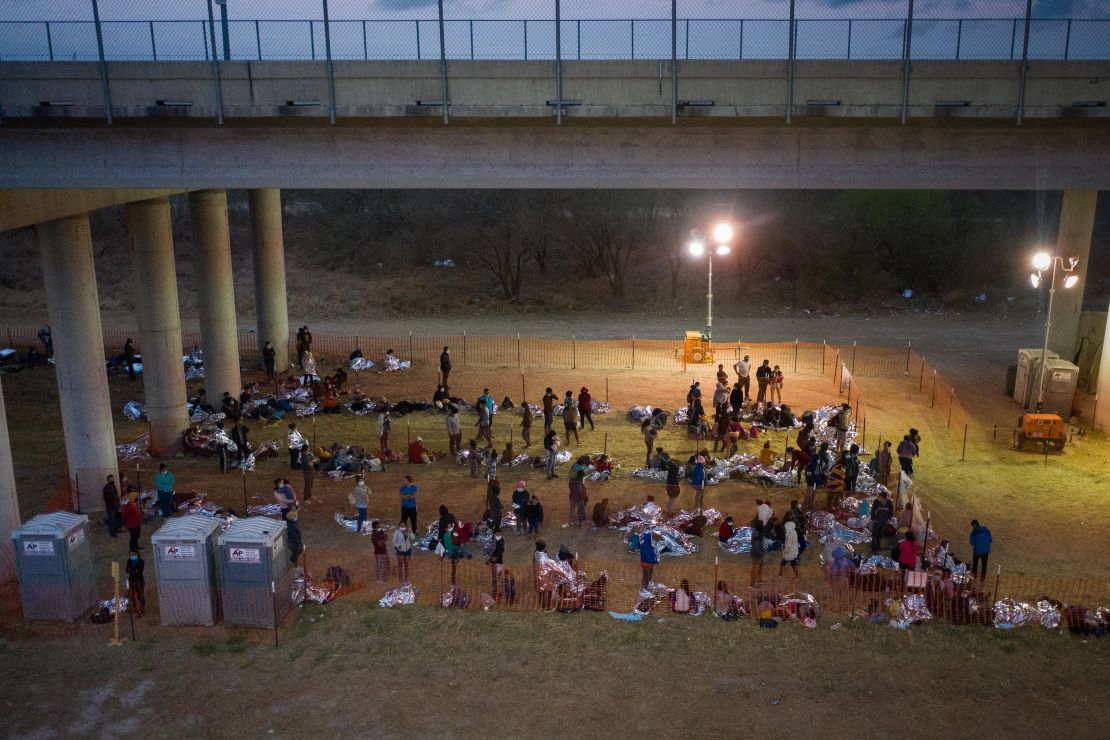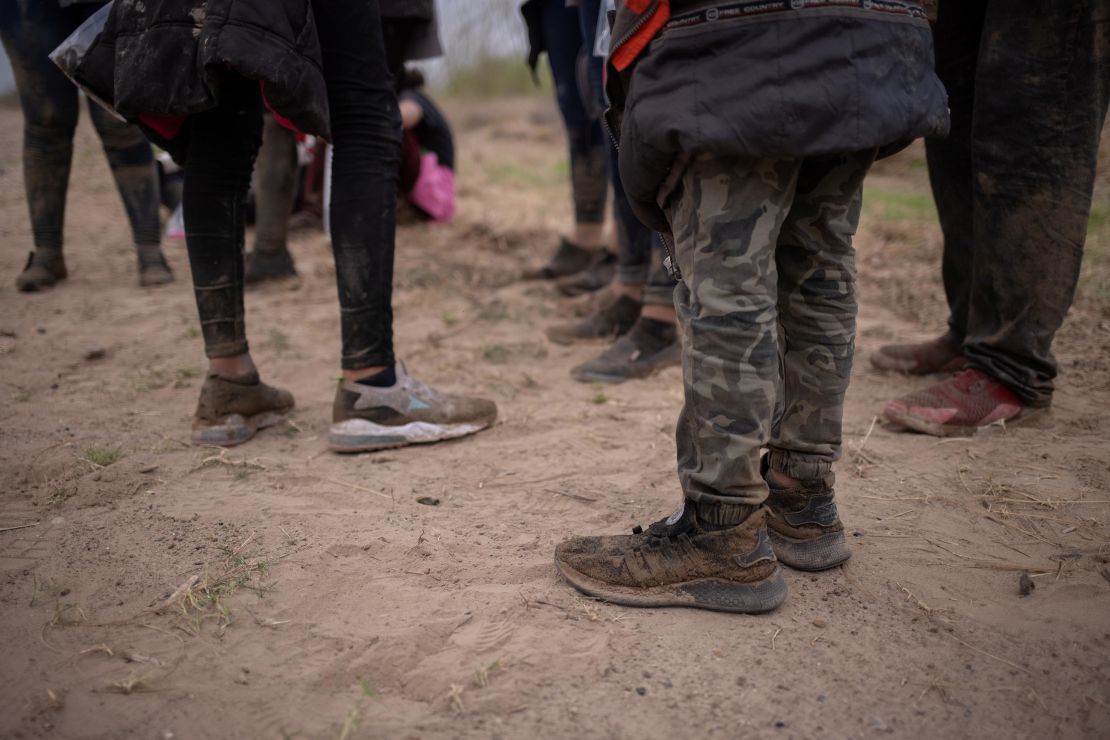Children are alternating schedules to make space for one another in confined facilities, some kids haven’t seen sunlight in days, and others are taking turns showering, often going days without one.
That’s the reality for the thousands of unaccompanied migrant children held up in US Border Patrol custody for days on end, according to case managers, attorneys and Border Patrol agents.
Bunk beds have been brought in to one of the processing facilities to help accommodate the influx of children. “Some of those are up to three bunks high,” an agent told CNN, adding that children are also sleeping on plastic cots and mats on the floor and benches.
More on Immigration
Customs and Border Protection is on pace to encounter more individuals on the border than in the last 20 years, Homeland Security Secretary Alejandro Mayorkas said Tuesday, adding that the agency is coming across children as young as six and seven years old.
More than 300 unaccompanied migrant children have been in Border Patrol custody for more than 10 days, CNN has learned. More than 4,200 minors are currently in custody, with an average time of 120 hours.
Asked about in-custody numbers, a Homeland Security official told CNN: “It’s terrible, it’s going up, it’s bad … we’re bludgeoned, totally over capacity.”
President Joe Biden discouraged would-be migrants from coming to the United States as the administration scrambles to respond to the surge of migrant children.
“I can say quite clearly: Don’t come,” Biden told ABC in an interview that aired on Tuesday.
“We’re in the process of getting set up. Don’t leave your town or city or community,” he added.
The experiences of migrant children arriving to the US underscore the steep challenge facing the Biden administration. That is accommodating the growing number of kids crossing the US-Mexico border alone against the backdrop of a pandemic that’s strained resources, particularly shelter space.
There are a myriad reasons why children are journeying to the US-Mexico border. Many are fleeing poverty and violence in Central America.
“There’s such a misunderstanding that they’re taking advantage or coming here for economic opportunity. But these are kids fleeing for basic needs to be met, for safety, for shelter, for food,” said a source who oversees case managers working with children. “Imagine what it’s like to be a refugee child coming to the United States during the pandemic.”
Marisa Limón Garza, deputy director at the Hope Border Institute, which works directly with migrants, said some families at the border have made the choice to send their children across alone.
“This comes with great sacrifice. I don’t think it’s lost on any of these parents. This is a grim choice,” Limón Garza said.
Why kids are stuck in jail-like facilities for more than the law allows
With an increasing number of children crossing the US-Mexico border alone, Border Patrol facilities are where kids have to stay until officials can transfer them to shelters that are appropriate for them. These facilities are designed to care for adults, not kids, and are akin to jail-like facilities with concrete walls and benches.
Children at stations in the Tucson, Arizona, region, for instance, have to be transported from Border Patrol stations to a central coordination center to get showers, the Border Patrol agent told CNN.
“There are kids that have been there days and days,” the agent said, pointing out that the agency is abiding by the law to care for children, except it is unable to meet the 72-hour legal requirement. “You just can’t right now.”
Federal law requires unaccompanied children to be turned over within 72 hours to the Department of Health and Human Services, which oversees a shelter network designed to house minors.

The senior official heading Customs and Border Protection, Troy Miller, told reporters that minors receive three meals daily, have 24/7 access to snacks and drinks and that showers are provided at least every 48 hours. They also have access to a recreation area, Miller said.
Mayorkas, who is scheduled to testify Wednesday before the House Homeland Security Committee, acknowledged the scope of the problem.
“The Border Patrol facilities have become crowded with children and the 72-hour timeframe for the transfer of children from the Border Patrol to [HHS] is not always met,” the Homeland Security secretary said in a statement Tuesday.
“HHS has not had the capacity to intake the number of unaccompanied children we have been encountering,” Mayorkas said.
In February, more than 9,400 children – ranging in ages – crossed the US-Mexico border, according to the latest available data from Customs and Border Protection. That’s up from January and is expected to continue trending upward.
On Monday, CBP encountered around 570 unaccompanied children, CNN has learned. Seventy-six were 12 years old and under.
“March will be bigger than February,” in terms of apprehensions based on current data, “and quite ugly” the Homeland Security official said.
Actions on the ground
Over the weekend, Mayorkas tapped the Federal Emergency Management Agency to help transfer kids out of Border Patrol custody and into shelters better suited for them.
“It’s busy and hard, but manageable,” a Homeland Security official said of how the department is handling the evolving situation on the ground.

DHS started two groups to coordinate and respond to the situation unfolding on the US-Mexico border, one led by the secretary and another led by the deputy secretary, the official said. Both groups have been meeting multiple times each week, the official told CNN, in addition to frequent calls and updates.
Democratic Rep. Veronica Escobar of Texas, who visited a border facility last week, called the situation “unacceptable” in an interview with the El Paso Times. “The center is at capacity – pre-COVID capacity. COVID capacity should be significantly lower. I did see everybody, including small children, wearing masks. It’s an unacceptable situation,” she said.
At the White House, Biden has quizzed aides on what more can be done through the executive branch to expedite processing of migrant children and expand the capacity for housing them. He’s raised the issue in informal meetings and during otherwise-unrelated discussions with senior advisers.
“When he’s asking questions and he’s asking for details, it’s not just a report back on numbers – what are the things we already have in our toolbox that we can be deploying?” the official added, saying that he’s encouraged staff to think outside the box. “Every single little space of White House operations, and of different agencies, are devoting time and resources to doing this and that’s what it’s going to take.”
In recent days, the Department of Health and Human Services announced it was opening two emergency intake centers in Texas to process unaccompanied children and alleviate overcrowding at Border Patrol facilities – one in a convention center in Dallas and another in Midland, Texas. Last month, HHS also opened up an influx facility in Carrizo Springs, Texas.
HHS also put a call out for volunteers within the department to deploy to border stations to help process children and expedite their release to a sponsor, like parent or relative, in the United States, according to a memo obtained by CNN.
Last Friday, the administration announced it would terminate a Trump-era agreement that officials said discouraged sponsors, like parents or relatives, from coming forward to collect their children.
There are more than 9,300 in the care of the Office of Refugee Resettlement, an agency under HHS, according to Kenneth Wolfe, a department spokesperson.
“The first time these children are feeling safe, potentially in years, is when they enter an [Office of Refugee Resettlement] shelter,” said Nathan Bult, senior vice president of public and government affairs for Bethany Christian Services, which works directly with unaccompanied children.
“That’s why it’s so important to provide high quality care for these children,” Bult said.
CNN’s Rosa Flores contributed to this report.























